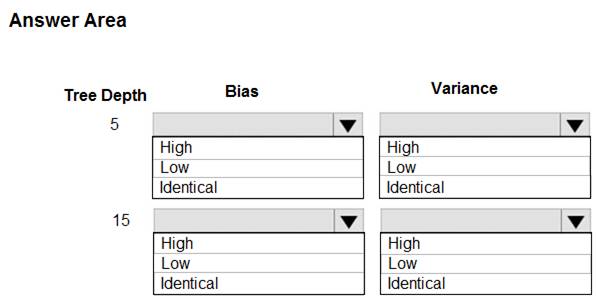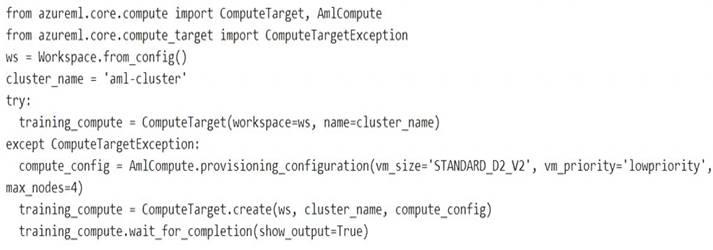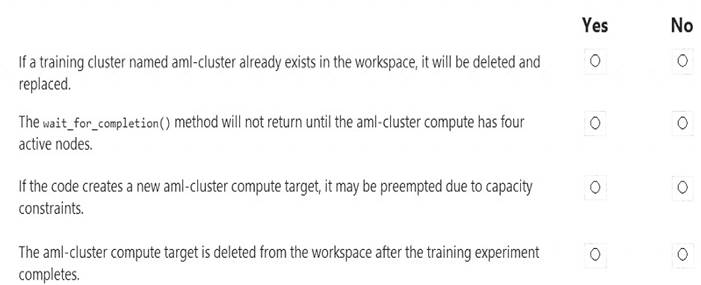- (Exam Topic 3)
Note: This question is part of a series of questions that present the same scenario. Each question in the series contains a unique solution that might meet the stated goals. Some question sets might have more than one correct solution, while others might not have a correct solution.
After you answer a question in this section, you will NOT be able to return to it. As a result, these questions will not appear in the review screen.
You are creating a new experiment in Azure Learning learning Studio.
One class has a much smaller number of observations than the other classes in the training
You need to select an appropriate data sampling strategy to compensate for the class imbalance. Solution: You use the Synthetic Minority Oversampling Technique (SMOTE) sampling mode. Does the solution meet the goal?
Correct Answer:
A
SMOTE is used to increase the number of underepresented cases in a dataset used for machine learning. SMOTE is a better way of increasing the number of rare cases than simply duplicating existing cases.
References:
https://docs.microsoft.com/en-us/azure/machine-learning/studio-module-reference/smote
- (Exam Topic 3)
You are using a decision tree algorithm. You have trained a model that generalizes well at a tree depth equal to 10.
You need to select the bias and variance properties of the model with varying tree depth values.
Which properties should you select for each tree depth? To answer, select the appropriate options in the answer area.
Solution:
In decision trees, the depth of the tree determines the variance. A complicated decision tree (e.g. deep) has low bias and high variance.
Note: In statistics and machine learning, the bias–variance tradeoff is the property of a set of predictive models whereby models with a lower bias in parameter estimation have a higher variance of the parameter estimates across samples, and vice versa. Increasing the bias will decrease the variance. Increasing the variance will decrease the bias.
References:
https://machinelearningmastery.com/gentle-introduction-to-the-bias-variance-trade-off-in-machine-learning/
Does this meet the goal?
Correct Answer:
A
- (Exam Topic 3)
You are performing feature scaling by using the scikit-learn Python library for x.1 x2, and x3 features. Original and scaled data is shown in the following image.
Use the drop-down menus to select the answer choice that answers each question based on the information presented in the graphic.
NOTE: Each correct selection is worth one point.
Solution:
Box 1: StandardScaler
The StandardScaler assumes your data is normally distributed within each feature and will scale them such that the distribution is now centred around 0, with a standard deviation of 1.
Example:
All features are now on the same scale relative to one another. Box 2: Min Max Scaler
Notice that the skewness of the distribution is maintained but the 3 distributions are brought into the same scale so that they overlap.
Box 3: Normalizer
References:
http://benalexkeen.com/feature-scaling-with-scikit-learn/
Does this meet the goal?
Correct Answer:
A
- (Exam Topic 3)
You are preparing to use the Azure ML SDK to run an experiment and need to create compute. You run the following code:
For each of the following statements, select Yes if the statement is true. Otherwise, select No.
NOTE: Each correct selection is worth one point.
Solution:
Box 1: No
If a training cluster already exists it will be used. Box 2: Yes
The wait_for_completion method waits for the current provisioning operation to finish on the cluster. Box 3: Yes
Low Priority VMs use Azure's excess capacity and are thus cheaper but risk your run being pre-empted.
Box 4: No
Need to use training_compute.delete() to deprovision and delete the AmlCompute target. Reference:
https://notebooks.azure.com/azureml/projects/azureml-getting-started/html/how-to-use-azureml/training/train-on https://docs.microsoft.com/en-us/python/api/azureml-core/azureml.core.compute.computetarget
Does this meet the goal?
Correct Answer:
A
- (Exam Topic 3)
You create an Azure Databricks workspace and a linked Azure Machine Learning workspace. You have the following Python code segment in the Azure Machine Learning workspace: import mlflow
import mlflow.azureml import azureml.mlflow import azureml.core
from azureml.core import Workspace subscription_id = 'subscription_id' resourse_group = 'resource_group_name' workspace_name = 'workspace_name'
ws = Workspace.get(name=workspace_name, subscription_id=subscription_id, resource_group=resource_group)
experimentName = "/Users/{user_name}/{experiment_folder}/{experiment_name}" mlflow.set_experiment(experimentName)
uri = ws.get_mlflow_tracking_uri() mlflow.set_tracking_uri(uri)
Instructions: For each of the following statements, select Yes if the statement is true. Otherwise, select No.
NOTE: Each correct selection is worth one point.
Solution:
A screenshot of a computer Description automatically generated with medium confidence
Box 1: No
The Workspace.get method loads an existing workspace without using configuration files. ws = Workspace.get(name="myworkspace",
subscription_id='
Box 2: Yes
MLflow Tracking with Azure Machine Learning lets you store the logged metrics and artifacts from your local runs into your Azure Machine Learning workspace.
The get_mlflow_tracking_uri() method assigns a unique tracking URI address to the workspace, ws, and set_tracking_uri() points the MLflow tracking URI to that address.
Box 3: Yes
Note: In Deep Learning, epoch means the total dataset is passed forward and backward in a neural network once.
Reference:
https://docs.microsoft.com/en-us/python/api/azureml-core/azureml.core.workspace.workspace https://docs.microsoft.com/en-us/azure/machine-learning/how-to-use-mlflow
Does this meet the goal?
Correct Answer:
A

